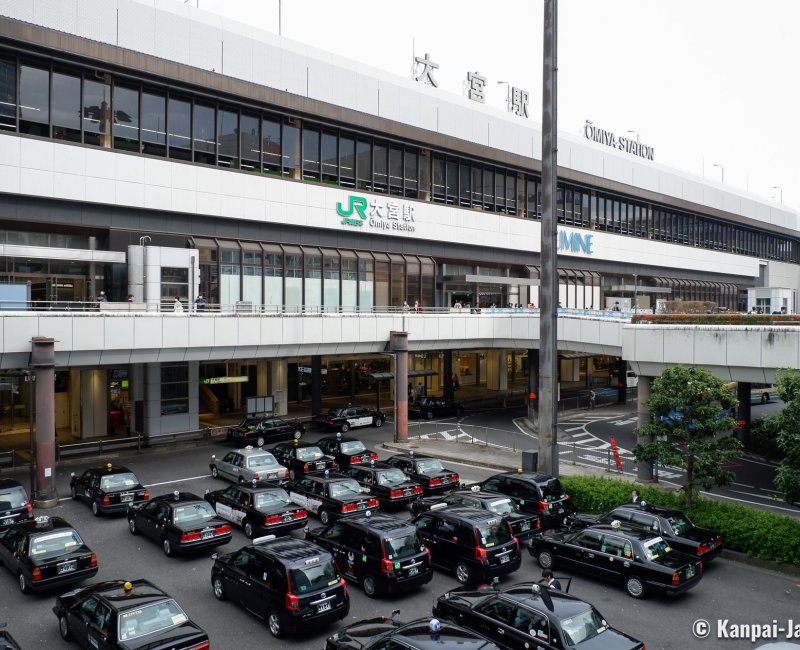Omiya
Saitama's Touristic Ward
Omiya is one of Saitama City’s 10 wards and is located at the northern limit of Tokyo. Its name, which means "great shrine", is a reference to the presence of Hikawa-jinja, one of the oldest and eminent Shinto shrines of Japan. Other popular places can be found in the area such as a bonsai museum and a railway museum.
Saitama is a destination usually forsaken by international tourists visiting Tokyo and its close surroundings. The city, and more broadly the eponymous prefecture, retain an authentic charm fostered by their inhabitants who enjoy living in a quiet neighborhood while benefiting from a convenient urban location. Sightseers will find in Omiya ward several beautiful visits that make an easy a one-day trip from the capital.
The local central hub is Omiya train 🚅 station that divides the ward in 2 parts: make sure to grab a map of the district at one of the information centers available upon getting off the train.

Historical visits near Hikawa-jinja
The station’s east exit serves the historical area of the ward that appears like a provincial city, especially with its entanglement of narrow quaint shopping streets. As a matter of fact, it was only in 2001 that the large administrative city of Saitama was created by merging the 3 villages of Omiya, Urawa and Yoko. The narrow West Side street is home to restaurants and Japanese pubs izakaya catering at night. A little bit further, the covered pedestrian alley Ichibangai offers a stroll amid various shops trying to attract patrons in a rather relaxed atmosphere.
Exiting the gallery for the open-air, continue to the majestic 2 kilometers long pedestrian avenue named Hikawa Sando, that leads the way to the entrance of Omiya’s great shrine. Bordered by 680 trees, mainly zelkova, castanopsis (called sudajii in Japanese) some of which are a hundred years old, as well as a few camphor trees, the sacred path is also punctuated by 3 tall vermilion Shinto gates:
- Ichi no Torii ⛩️ is the first gate and the farthest from the shrine, showing the beginning of the path,
- Ni no Torii is standing at the second third of the way. A gift from Tokyo’s Meiji-jingu shrine, the gate was cut from a 1,200 year old cedar tree and is 13 meters high,
- San no Torii is the closest great gate from the Shinto grounds. Nearby a 13,32 meters long panel displays a modern reproduction of an emaki painted scroll narrating the visit of Meiji Emperor at the shrine in 1868.

Wonderful, vast and infused with spirituality, Hikawa-jinja is a must-see when visiting Saitama. Surrounding the shrine, Omiya Park is particularly recommended when its 1,200 sakura 🌸 bloom at the beginning of spring. The park is a popular spot for celebrating ohanami, the cherry blossom viewing.
Staying in the botanical field, bonsai cultivation is a specialty of Omiya ; 2 sites are to be discovered in relation to this traditional art:
- Omiya Bonsai Village, gathering 6 gardens dedicated to the skillfully trimmed miniature trees, and,
- Omiya Bonsai Art Museum.
On the travel back, along the tracks at the north of station, the visit of the eastern part of the ward ends at The Railway Museum, which is the largest railway touristic site in Japan, and the dream land of all densha otaku train passionate.

The modern city at the west of the station
On Omiya station’s western side, the atmosphere is clearly more onto concrete modern constructions, with LCD screens broadcasting advertisement all day long on a loud background music. From an elevated platform, one can watch the ballet of vehicles around the taxis and bus stations.
Huge shopping malls are home to all the brands necessary to the locals for their shopping, entertainment or to eat. Somewhat behind, narrow streets shelter establishments of a less smooth reputation, such kyabakura (hostess club), their male counterpart host clubs and the notorious snacks managed by a mama. The area reminds of Kabukicho night district in Shinjuku.
Kanezuka Park, a green space also boasting a few cherry trees, spreads at the foot of the Sonic City Hall event venue. When nice weather returns, this relaxing area is filled by the surroundings’ workers who settle on a bench or on a stair to take a break under the sun. The larger avenues lead to areas that are more residential and less touristic.
While not extravagant, Omiya has a long history that fosters its touristic attractiveness over a day-trip in the northern suburb of Tokyo. During the Edo period (1603 – 1868), the village was a station named Omiya-shuku along the former Nakasendo Route.


